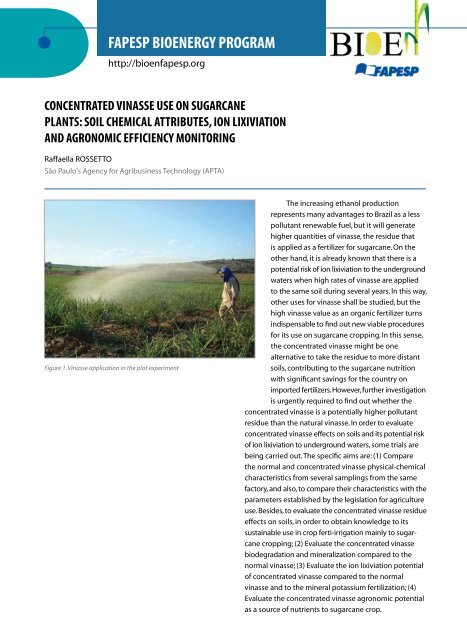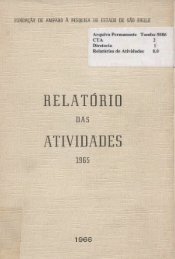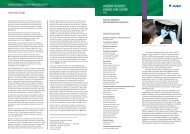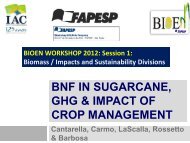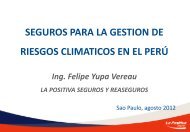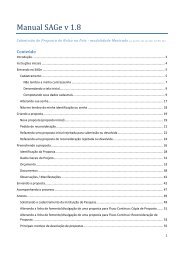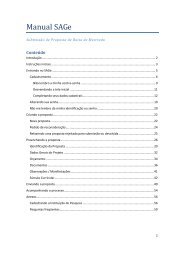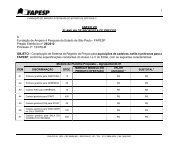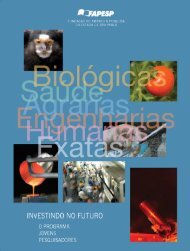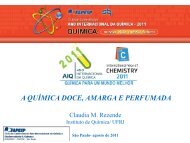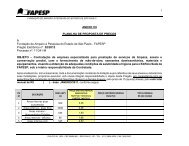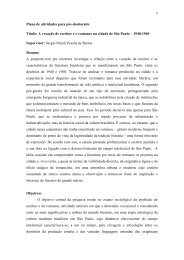FAPESP BIOENERGY PROGRAM cONcENtRAtEd VINASSE uSE ...
FAPESP BIOENERGY PROGRAM cONcENtRAtEd VINASSE uSE ...
FAPESP BIOENERGY PROGRAM cONcENtRAtEd VINASSE uSE ...
Create successful ePaper yourself
Turn your PDF publications into a flip-book with our unique Google optimized e-Paper software.
<strong>FAPESP</strong> <strong>BIOENERGY</strong> <strong>PROGRAM</strong><br />
http://bioenfapesp.org<br />
<strong>cONcENtRAtEd</strong> <strong>VINASSE</strong> <strong>uSE</strong> ON SuGARcANE<br />
PlANtS: SOIl chEMIcAl AttRIButES, ION lIxIVIAtION<br />
ANd AGRONOMIc EFFIcIENcY MONItORING<br />
Raffaella RosseTTo<br />
são Paulo's Agency for Agribusiness Technology (APTA)<br />
Figure 1. Vinasse application in the plot experiment<br />
The increasing ethanol production<br />
represents many advantages to Brazil as a less<br />
pollutant renewable fuel, but it will generate<br />
higher quantities of vinasse, the residue that<br />
is applied as a fertilizer for sugarcane. on the<br />
other hand, it is already known that there is a<br />
potential risk of ion lixiviation to the underground<br />
waters when high rates of vinasse are applied<br />
to the same soil during several years. in this way,<br />
other uses for vinasse shall be studied, but the<br />
high vinasse value as an organic fertilizer turns<br />
indispensable to find out new viable procedures<br />
for its use on sugarcane cropping. in this sense,<br />
the concentrated vinasse might be one<br />
alternative to take the residue to more distant<br />
soils, contributing to the sugarcane nutrition<br />
with significant savings for the country on<br />
imported fertilizers. However, further investigation<br />
is urgently required to find out whether the<br />
concentrated vinasse is a potentially higher pollutant<br />
residue than the natural vinasse. in order to evaluate<br />
concentrated vinasse effects on soils and its potential risk<br />
of ion lixiviation to underground waters, some trials are<br />
being carried out. The specific aims are: (1) Compare<br />
the normal and concentrated vinasse physical-chemical<br />
characteristics from several samplings from the same<br />
factory, and also, to compare their characteristics with the<br />
parameters established by the legislation for agriculture<br />
use. Besides, to evaluate the concentrated vinasse residue<br />
effects on soils, in order to obtain knowledge to its<br />
sustainable use in crop ferti-irrigation mainly to sugarcane<br />
cropping; (2) evaluate the concentrated vinasse<br />
biodegradation and mineralization compared to the<br />
normal vinasse; (3) evaluate the ion lixiviation potential<br />
of concentrated vinasse compared to the normal<br />
vinasse and to the mineral potassium fertilization; (4)<br />
evaluate the concentrated vinasse agronomic potential<br />
as a source of nutrients to sugarcane crop.
<strong>FAPESP</strong> <strong>BIOENERGY</strong> <strong>PROGRAM</strong><br />
SuMMARY OF RESultS<br />
tO dAtE ANd PERSPEctIVES<br />
This project started in november 2009 by plotting<br />
the field experiment. The area used was located in Batatais<br />
region, são Paulo state, and the sugarcane was in the first<br />
ratton stage. The results reported at the present are still<br />
preliminary being the conclusions expected in september<br />
– october of 2010 by harvesting the plants and analyzing<br />
all the samples for monitoring vinasse uses.<br />
in the experiment, samples of two kinds of vinasse were<br />
applied, one is the vinasse that is normally obtained in the<br />
ethanol production (normal vinhasse), and the second is a<br />
concentrated vinasse, both proceeding of the same sugarcane<br />
mill. A scheme for sampling and analyzing vinasse samples<br />
periodically was established so the different vinasses were<br />
compared (Table 1). The results showed that chemicals<br />
properties of both vinasses are similar, however macro-<br />
nutrients concentrations, especially potassium (K), are higher<br />
in concentrated vinasse. There were variations on macronutrients<br />
contents in vinasse through the months, but in<br />
general, K concentrations have been 20 to 30 times higher<br />
in concentrated vinasse.<br />
soil samples, obtained from the field experiment, were<br />
taken to the laboratory to evaluate carbon (C) and nitrogen<br />
(n) mineralization after normal vinasse and concentrated<br />
vinasse application. The preliminary results of these tests<br />
showed that C and n mineralization occurs faster with<br />
normal vinasse when compared to concentrated vinasse.<br />
Table 1. Macronutrients and pH in concentrated vinasse<br />
compared with normal vinasse<br />
pH N PO4I K2O gl<br />
Ca Mg SO4 4,1 0,35 0,08 2,18 0,19 0,35 1,1<br />
4,1 3,7 1,3 52,8 3,1 4,4 18,2<br />
-1<br />
vinasse<br />
Concentrated<br />
vinasse<br />
n – Kjeldahl, K – flame photometry, P, Ca, Mg, so4 – iCP-Aes<br />
MAIN PUBLICATIONS<br />
Bertoncini ei, Mattiazzo Me, Rossetto R. 2004.<br />
sugarcane yield and heavy metal availability in two<br />
biosolid-amended oxisols. Journal of Plant Nutrition.<br />
27:1243-1260.<br />
oliveira FC, Mattiazzo Me, Marciano CR, Rossetto R.<br />
2002. efeito de aplicações sucessivas de lodo de<br />
esgoto em um latossolo Amarelo Distrófico<br />
cultivado com cana-de-açúcar: carbono orgânico,<br />
condutividade elétrica, pH e CTC. Revista Brasileira<br />
de Ciência do Solo. 26:505-519.<br />
Rossetto R. 2008. A cana-de-açúcar e a questão<br />
ambiental. in: Dinardo-Miranda l l, vasconcelos ACM,<br />
landell MGA. eds. Cana-de-açúcar. 1ª. ed. 1:869-882.<br />
Rossetto R. 2004. A cultura da cana, da degradação à<br />
conservação. Scientia Agrícola. 1:80-85.<br />
Rossetto R, Cantarella H, Dias FlF.2008. Manejo<br />
conservacionista e reciclagem de nutrientes em<br />
cana-de-açúcar tendo em vista a colheita mecânica.<br />
Informações Agronômicas. 124:8-13.<br />
Rossetto R., Dias FlF, vitti A, Tavares s. Potássio. in:<br />
Dinardo-Miranda ll, vasconcelos ACM, landell MGA.<br />
eds. Cana-de-açúcar 1ª. ed. 1:289-311.<br />
Raffaella Rossetto<br />
Agência Paulista de Tecnologia dos Agronegócios<br />
(APTA) – Pólo Regional Centro sul<br />
Rodovia sP 127 – Km 30<br />
Caixa Postal 28<br />
CeP 13400-970 – Piracicaba, sP – Brasil<br />
+55-19-3421-1478<br />
raffaella@apta.sp.gov.br


